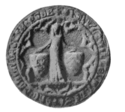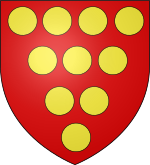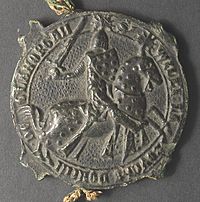Eleanor de Clare facts for kids
Quick facts for kids
Eleanor de Clare
|
|
|---|---|
| Suo jure Lady of Glamorgan | |

Eleanor de Clare
|
|
| Other titles | Baroness le Despenser Baroness la Zouche |
| Born | 3 October 1292 Caerphilly Castle, Glamorgan, Wales |
| Died | 30 June 1337 (age 44) Monmouth Castle, Monmouthshire, Wales |
| Buried | Tewkesbury Abbey 51°59′25″N 2°09′37″W / 51.9903°N 2.1604°W |
| Spouse(s) |
William la Zouche
(m. 1329) |
| Issue | Hugh le Despenser, Baron le Despenser Edward le Despenser Isabel le Despenser, Countess of Arundel Joan le Despenser Gilbert le Despenser John le Despenser Eleanor le Despenser Margaret le Despenser Elizabeth le Despenser, Baroness Berkeley William la Zouche |
| Father | Gilbert de Clare, 7th Earl of Gloucester |
| Mother | Joan of Acre |
Eleanor de Clare (born 3 October 1292 – died 30 June 1337) was an important noblewoman in England and Wales. She was the granddaughter of Edward I of England, a powerful king. Eleanor became very influential when she married Hugh Despenser the Younger. He was a close friend and advisor to her uncle, King Edward II of England.
Eleanor was born in 1292 at Caerphilly Castle in Glamorgan, Wales. She was the oldest daughter of Gilbert de Clare, 6th Earl of Hertford, and Princess Joan of Acre.
Contents
Eleanor's Family Inheritance
Eleanor had two younger sisters, Elizabeth de Clare and Margaret de Clare. In 1314, their brother, Gilbert de Clare, 8th Earl of Gloucester, died in a battle. Because he had no children, Eleanor and her sisters inherited their father's large estates. These lands included the important area of Glamorgan and many other properties.
It took a few years for the inheritance to be fully divided among the sisters. During this time, Caerphilly Castle, a family home, was looked after by the king's representative. In 1316, a Welsh nobleman named Llywelyn Bren attacked the castle. Eleanor, known as "The lady of Clare," bravely helped defend it with a small group of soldiers. The castle held out until help arrived.
Marriage to Hugh Despenser the Younger
In May 1306, Eleanor married Hugh le Despenser the Younger in Westminster. Hugh's father was also a powerful nobleman. Through this marriage, Hugh became the Lord of Glamorgan. Eleanor's grandfather, King Edward I, gave her a large gift of money, about 2,000 pounds, as a dowry.
Eleanor's husband, Hugh, became very close to King Edward II of England, who was Eleanor's uncle. The King liked Hugh and Eleanor a lot. He often visited them and gave them many gifts. This made Eleanor and Hugh very powerful and wealthy.
However, their good fortune did not last. In September 1326, King Edward II's wife, Queen Isabella, and her ally, Roger Mortimer, 1st Earl of March, invaded England. They took control of the country and removed the King from power. Two months later, Eleanor's husband, Hugh, was found guilty of a serious crime against the king and was executed.
Eleanor and Hugh's Children
Eleanor and Hugh had nine children together:
- Hugh le Despenser (born around 1308/9 – died 1349). He became a Baron and was called to Parliament.
- Edward le Despenser (born around 1310 – died 1342). He was a soldier. His son, also named Edward, later became a Baron.
- Isabel le Despenser, Countess of Arundel (born around 1312 – died after 1356). She married Richard Fitzalan, 10th Earl of Arundel. Their marriage was later cancelled.
- Joan le Despenser (born around 1314 – died 1384). She became a nun.
- Gilbert le Despenser (born around 1316 – died 1382).
- John le Despenser (born around 1317 – died 1366).
- Eleanor le Despenser (born around 1319 – died 1351). She also became a nun.
- Margaret le Despenser (born around August 1323 – died 1337). She became a nun.
- Elizabeth le Despenser (born around December 1325 – died 1389). She married Maurice de Berkeley, 4th Baron Berkeley.
Eleanor's Imprisonment
After her husband's execution in November 1326, Eleanor was sent to the Tower of London. Her family also lost much of their wealth and power. Eleanor and Hugh's oldest son, Hugh, held Caerphilly Castle against the queen's forces for some time. He was eventually captured but was allowed to live. He remained a prisoner until 1331, but later regained the king's favor.
Three of Eleanor's daughters were forced to become nuns. Only her oldest daughter, Isabel, who was already married, and her youngest daughter, Elizabeth, who was still a baby, avoided this fate. Eleanor herself was freed from prison in February 1328. In April 1328, she got her own lands back after promising loyalty to the new king.
Marriage to William de la Zouche
In January 1329, Eleanor was taken from Hanley Castle by William la Zouche. He had been one of the people who captured her first husband. It's possible that Eleanor went with him willingly, as an elopement. However, King Edward III of England took away Eleanor's lands, and both Eleanor and William were ordered to be arrested. Eleanor was also accused of stealing jewels from the Tower of London.
Eleanor was imprisoned again in the Tower of London, and then moved to Devizes Castle. In January 1330, she was released. To gain her freedom, she had to sign away the most valuable part of her inheritance to the crown. She could only get her lands back if she paid a huge amount of money, 50,000 pounds, all at once.
However, things changed for Eleanor later that year. The young King Edward III (who was Eleanor's cousin) removed Queen Isabella's close ally, Roger Mortimer, 1st Earl of March, from power and had him executed. Eleanor was one of the people who benefited from this change. She asked King Edward III to give her lands back, saying she had only given them up because Roger Mortimer had threatened her.
In 1331, King Edward III agreed to her request. He allowed her to get her lands back, but she still had to pay a fine of 10,000 pounds, which was later lowered to 5,000 pounds. Eleanor made some payments, but she still owed a lot of money when she died.
Eleanor's troubles were not completely over. After she married William de la Zouche, another man, John de Grey, 1st Baron Grey de Rotherfield, claimed that he had married her first. This legal case went to the Pope many times. In the end, William de la Zouche won the dispute, and Eleanor remained with him until his death in February 1337. Eleanor herself died only a few months later.
Eleanor and William had one child:
- William de la Zouche (born 1330 – died after 1360). He became a monk.
Tewkesbury Abbey Renovations
Eleanor and her first husband, Hugh le Despenser the Younger, are believed to have started the major renovations at Tewkesbury Abbey. This abbey was founded by Eleanor's ancestors. Their work helped transform it into one of the most beautiful examples of a special type of architecture from the 1300s.
The famous stained-glass windows in the choir of the abbey, which show figures of Eleanor's ancestors, her brother, and her two husbands, were most likely Eleanor's idea. She probably did not live to see them finished. A kneeling woman in one of the windows, watching the Last Judgment, might be Eleanor herself.
Fictional Stories About Eleanor
Eleanor is a character in Les Rois maudits (The Accursed Kings), a series of French historical novels by Maurice Druon. She has been played by actresses in TV adaptations of these books.
Eleanor also appears in the two-part novel Feudal Family: The De Clares of Gloucester by Edith Beadle Brouwer. She is the main character in Susan Higginbotham's historical novel The Traitor's Wife: A Novel of the Reign of Edward II, which came out in 2005.



